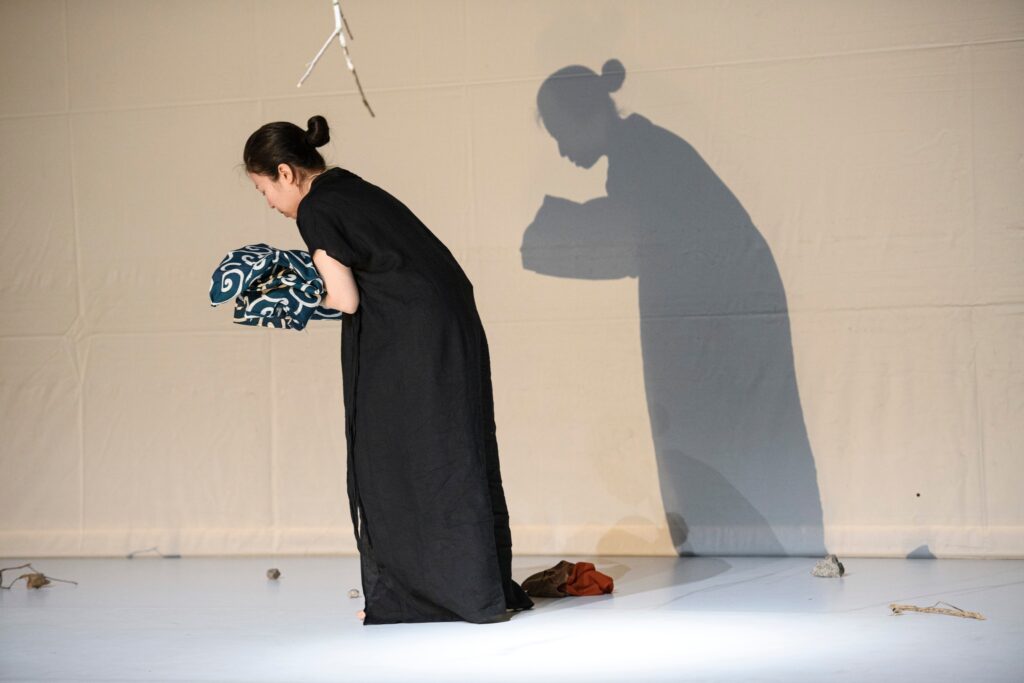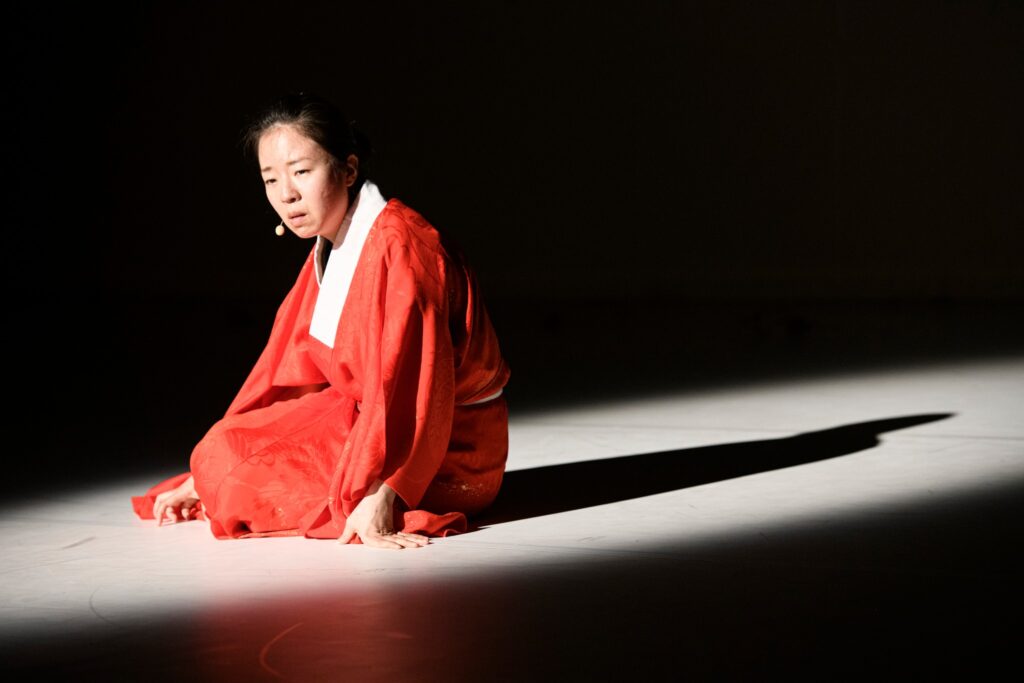„Jeden Tag einen Nährboden für Frieden, Gewaltlosigkeit und Heilung zu schaffen. Gewalt, nicht zu unserer Norm zu machen.“, antwortet die Sängerin und Performerin Aine Nakamura auf die Frage „Was ist (uns) die Zukunft wert?“ Autor Ilias Botseas beschreibt die Performance „Circle Hasu – We plant seeds in the spring of mountains.“ der Stückemarkt-Stipendiatin.
for the English version please scroll down
Ich versuche zunächst die Solo-Performance von Aine Nakamura als Geschichte zu verstehen und zu interpretieren – schließlich bin ich es gewohnt, Figuren, Handlungen, Politiken und Gesellschaften auf der Bühne zu rezipieren und Ästhetiken zu perzipieren. Da diese Gesichtspunkte sehr weit gefasst sind, lassen sie sich auch auf Nakamuras Performance anwenden: so ist sie selbst die Protagonistin, ihre Reise durch und Erfahrung von Natur die Handlung, ein klarer Pazifismus ihre Politik und ihre Diskriminierungserfahrungen ein Bild der Gesellschaft, geformt in einer Blackbox mit unterschiedlichen Requisiten wie Ästen und einem Kimono auf der Bühne. Doch merke ich schnell, dass ich das Bühnengeschehen mit der Erwartungshaltung einer klassischen Narration nicht deuten kann, denn Nakamura verwendet fast nur poetische Sprache, die Naturbilder vermittelt, und onomatopoetischen Gesang, der ihre Gefühlslage und Wahrnehmung vermittelt – macht ihre Stimme zum Instrument ihres Innenlebens. Also entspanne ich mich und versuche, meinen Körper zu öffnen, um mich auf die Klänge und Bilder einzulassen und Assoziationen zuzulassen, ohne direkt alles kognitiv einordnen zu müssen.
Ein Abend von Spannungsverhältnissen und Zyklen
Lotusblumen (jap. „Hasu“) blühen und verwelken, Eichhörnchen sammeln Nüsse und sind im nächsten Moment tot, Wollmispeln ragen majestätisch gen Himmel. Sie sind einst Samen gewesen, die nach dem Essen der Früchte auf den kargen Erdboden gespuckt worden sind.
Diese Sätze vermitteln Bilder eines natürlichen Zyklus und setzen den Ton des Abends, setzen alles in ein Spannungsverhältnis zueinander: Leben und Tod, Wind und Boden, Organismen und anorganische Materie, Mensch und Natur, Natur und Kosmos, Natur und Urbanität, Performerin und Zuschauende, Geist und Körper, Körper und Stimme, Gewalt und Frieden, Westen und Osten, Chaos und Ordnung, Stimme und Emotion, Furcht und Gelassenheit. Sie fließen ineinander über und verformen sich, schaffen dabei Wunden, die nach einer Weile heilen und die Zeit mit Narben skulptieren.
Konfrontation mit mir selbst
Ich deute Nakamuras Stimme und hinterfrage meine Deutung sofort, beziehe ihre Diskriminierungserfahrungen auf meine eigenen Erfahrungen, denke über meine eigene transnationale Doppelidentität sowie über mein Verhältnis zur Natur nach. Während ich in der Performance eine Heilung durch die Natur interpretiere, bemerke ich meine eigene Entfremdung zur Natur, wie stark meine Lebensrealität von den Darstellungen auf der Bühne divergiert. Ich denke über meine körperliche und mentale Gesundheit nach, denke über das System nach, in das ich geboren worden bin, in welches ich mich unterordne; was ich zu mir nehme, was die Großstadt mit mir macht, wie ich meine Kindheit auf dem kleinen Dorf, an das ich selten zurückdenke, retrospektiv wahrnehme. Ich hinterfrage auf einer körperlichen Ebene, wer ich bin, was mein Verhältnis zur Umwelt prägt und wo ich mich im Kosmos befinde. Denke an meine Mortalität. Denke an meine Eltern und Großeltern. Bemerke die Distanz, die ich zu meiner Familie aufgebaut habe. Schaue auf den Boden und bin in Gedanken versunken.
Die Performance schafft etwas, das ich lange nicht erlebt habe: nämlich mich auf etwas einzulassen, das durch Nahbarkeit und Poesie einen Sog entwickelt, mich fordert und einen Nährboden für meine eigene Gedanken und Gefühle schafft. Ich empfinde das konsequent sinnliche Bühnengeschehen als philosophischen Abend, der mich tagelang beschäftigt.
Zwischen Logos und Lotus
Die Performance endet damit, dass das Eichhörnchen, das am Anfang noch lebendig gewesen und später verstorben ist, im Erdboden von Blättern bedeckt ist und dessen Körper zurück in den Kosmos fließt, wieder Teil der Natur wird. Nakamura legt den Lotus, der im Buddhismus ein Symbol für Eleganz, Vollkommenheit und Reinheit für Körper, Sprache und Geist ist, auf ihren Körper. Sie beschreibt, wie Sonne und Mond in den Kosmos fließen und die Trauer zur Herzlichkeit des Meeres wird, alles Irdische transzendiert.
Ich muss an Heraklit denken, der in einem seiner Fragmente beschreibt: „Für die Seelen ist es Tod zu Wasser zu werden, für das Wasser Tod zur Erde zu werden. Aus der Erde wird Wasser, aus Wasser Seele.“
Für den vorsokratischen Philosophen der griechischen Antike steht alles in einem Spannungsverhältnis zwischen extremen Enden zueinander, zwischen denen es immerzu fließt, oder „panta rhei“, wie es in seiner bekanntesten Formulierung heißt. Alles entsteht im Weltfeuer und unterliegt dem Logos, der vernunftgemäßen Weltordnung, die uns allen einverleibt ist.Im fließenden Prozess des Werdens bleibt uns also nur in uns zu gehen und dem Kosmos zu horchen, um vielleicht etwas zu finden, das uns Kraft und Sinn gibt – zwischen Leben und Tod, zwischen Mensch und Natur, zwischen Logos und Lotus.

Between logos and lotus
„To create a breeding ground for peace, non-violence and healing every day. To make violence, not our norm.“ is how singer and performer Aine Nakamura responds to the question „What is the future worth (to us)?“ Author Ilias Botseas describes the performance „Circle Hasu – We plant seeds in the spring of mountains.“ by the Stückemarkt fellow.
I first try to understand and interpret Aine Nakamura’s solo performance as a story – after all, I am used to receiving characters, plots, politics and societies on stage and to perceiving aesthetics. Since these points of view are very broad, they can also be applied to Nakamura’s performance: thus, she herself is the protagonist, her journey through and experience of nature is the plot, a clear pacifism is her politics, and her experiences of discrimination are an image of society, formed in a black box with various props such as branches and a kimono on stage. But I quickly realize that I cannot interpret the stage action with the expectation of a classical narration, because Nakamura uses almost only poetic language that conveys images of nature, and onomatopoeic singing that conveys her emotional state and perception – making her voice the instrument of her inner life. So I relax and try to open my body to engage with the sounds and images and allow associations without having to directly categorize everything cognitively.
An evening of tensions and cycles
Lotus flowers (jap. „Hasu“) blossom and wither, squirrels gather nuts and are dead the next moment, loquat trees rise majestically to the sky. They were once seeds that were spat onto the barren ground after eating the fruit.
These phrases convey images of a natural cycle and set the tone of the evening, placing everything in tension with each other: life and death, wind and soil, organisms and inorganic matter, human and nature, nature and cosmos, nature and urbanity, performer and spectator, mind and body, body and voice, violence and peace, West and East, chaos and order, voice and emotion, fear and serenity. They flow into each other and deform, creating wounds that heal after a while and sculpt time with scars.
Confrontation with myself
I interpret Nakamura’s voice and immediately question my interpretation, relating her experiences of discrimination to my own experiences, reflecting on my own transnational double identity as well as my relationship to nature. As I interpret a healing through nature in the performance, I notice my own alienation from nature, how much my life reality diverges from the representations on stage. I think about my physical and mental health, think about the system I was born into, into which I subordinate myself; what I ingest, what the big city does to me, how I retrospectively perceive my childhood in the small village I rarely think back to. I question on a physical level who I am, what shapes my relationship to the environment, and where I am in the cosmos. Think of my mortality. Think of my parents and grandparents. Notice the distance I have built with my family. Look at the floor and am lost in thought.
The performance creates something I haven’t experienced in a long time: namely, engaging with something that develops a pull through closeness and poetry, challenging me and creating a fertile ground for my own thoughts and feelings. I experience the consistently sensual stage event as a philosophical evening that occupies me for days.
Between logos and lotus
The performance ends with the squirrel, which was alive at the beginning and later died, covered by leaves in the ground and its body flowing back into the cosmos, becoming part of nature again. Nakamura places the lotus, which in Buddhism is a symbol of elegance, perfection and purity for body, speech and mind, on her body. She describes how the sun and moon flow into the cosmos and sorrow becomes the kindness of the sea, transcending all that is earthly.
I have to think of Heraclitus, who describes in one of his fragments: „For souls it is death to become water, for water death to become earth. Earth becomes water, water becomes soul.“
For the pre-Socratic philosopher of ancient Greece, everything is in tension between extreme ends to each other, between which it is always flowing, or „panta rhei“ as it is called in his most famous formulation. Everything comes into being in the world fire and is subject to the logos, the rational world order, which is incorporated in all of us.
So, in the flowing process of becoming, all that remains is for us to go within ourselves and listen to the cosmos to perhaps find something that gives us strength and meaning – between life and death, between human and nature, between logos and lotus.
